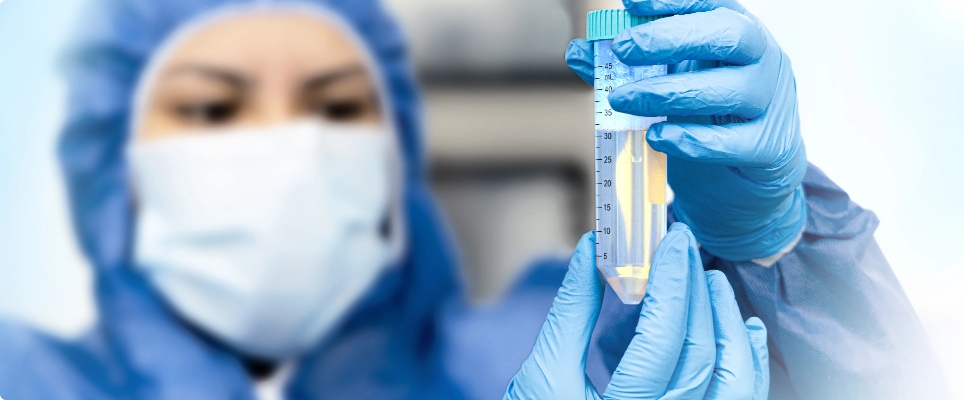BioXcellerator Signature Cells Quality Control and Attributes

We follow the guidelines of the International Society for Stem Cell Therapy (ISCT) and the International Society for Stem Cell Research (ISSCR) to establish our quality control process and the minimum and additional quality attributes of our BioXcellerator Signature Cells.
Since choosing one of the best sources of stem cells, the Wharton´s Jelly from the umbilical cord (WJ-MSC), the preparations have full safety and quality control check-up according to the GMP requirements and consists of five steps.
Step 1: Inclusion and exclusion criteria
The first step for the obtention of WJ-MSC occurs at the stage of donation. Three months before the delivery, our team contact possible donors and run a check list to guaranty the absence of risk factors, including viral infections and pathologies that may have impact on the genes of WJ-MSC. Also, we just collect umbilical cords from c-section, to reduce at minimum, the risk of contamination with microorganism through the birth canal.
Step 2: Microbiology control
Microbiology control begins after umbilical cord sample collection, both the blood from the mother and from the umbilical cord pass through blood culture tests and antibody serology tests for a set of infectious diseases, including CMV, HBV, HIV 1 and 2, HCV, Toxoplasma, Syphilis, T. cruzy, HTLV 1 and 2, to rule out any risk during processing. The tests are performed for a certified third-lab part to avoid the bias. Once we obtain the primary cultures of WJ-MSC and all along the expansion process, each preparation is checked on microbiology sterility several times (passages 1-7), and before and after cryopreserving. Microbiology control is carried out in our own facility, for absence of aerobic, anaerobic and faculty anaerobic microorganism, yeasts, and fungus.
Step 3: Phenotype control and minimum quality attributes: Morphology, characterization, cells viability and differentiation
Each WJ-MSC culture during all the passages, is analyzed by our highly qualified staff with more than 10 years of experience in cell culture. Control of morphology and homogeneity of cell culture, for absence of aggregations, artefacts and inclusions is conducted through inverted microscope daily monitoring. All batches of WJ-MSC undergo characterization and cell viability control, which is performed by the immunophenotyping on a flow cytometer. On this quality control level, WJ-MSCs are immunophenotypically characterized by the presence of positive surface markers (percentage of expression over 90% of CD73, CD90 and CD105) and absence of CD45, CD34 and HLA class II (percentage of expression below 2%), according to the criteria of the ISCT. The percentage of live stem cells in our preparations is 90 +/- 10%, and to make up for this, we always cryopreserved 10% more in each batch. Finally, we evaluated the differentiation capacity of the WJ-MSC to the mesodermal lineage, specifically the differentiation to chondrocytes, adipocytes, and osteoblasts in vitro. Our cells differentiate in less time according to the standards, demonstrating their great potential.
Step 4: Additional quality attributes
Also, we check senesce, karyotype and extracellular vesicle secretion (exosomes), which indicate the stability of our cell lines. Additionally, every week we carry out the thawing control, and follow-up of viability and morphology is carried out for 96 hours, to guarantee that the cell product used in the therapy remains viable.
Step 5: Final control before clinical use
Before therapy preparation WJ-MSC we automatically count live cells to determine the viability and also to confirm the quantity, what makes us sure the quality of the preparation.
All our WJ-MSC used for therapies passed all the steps of safety and quality controls, and the batches we use are no older than 16 weeks. Each patient receives cells from the same batch in all their applications, to guarantee traceability.
Benefits of Wharton’s Jelly Mesenchymal stem cells (WJ-MSC):
- Invasive procedures are not required to obtain WJ-MSCs, and these cells have also been shown to have an in vitro replication capacity much higher than other sources.
- Absence of spontaneous transformation and uncontrolled differentiation of cells, which leads to tumorigenicity, like embryonic stem cells.
- MSCs are multipotent cells capable of multi-differentiation and self-renewal.
- One of the great therapeutic advantages of stem cells derived from Wharton’s jelly over other origins is that, in addition to expressing typical mesenchymal markers, they also express modestly pluripotency genes, which may confer better efficacy with greater safety.
- Injection of WJ-MSCs is extra cells for the patient’s body (average of 180 million of cells for patient), unlike the use of autologous stem cells of stromal vascular fraction derived from adipose tissue which is limited.
- In addition to the advantages of obtaining and expanding cells, WJ-MSC have also shown advantages in their immunomodulatory profile, evidencing that they have greater activity on lymphocytes, through the regulation of the different cell populations.